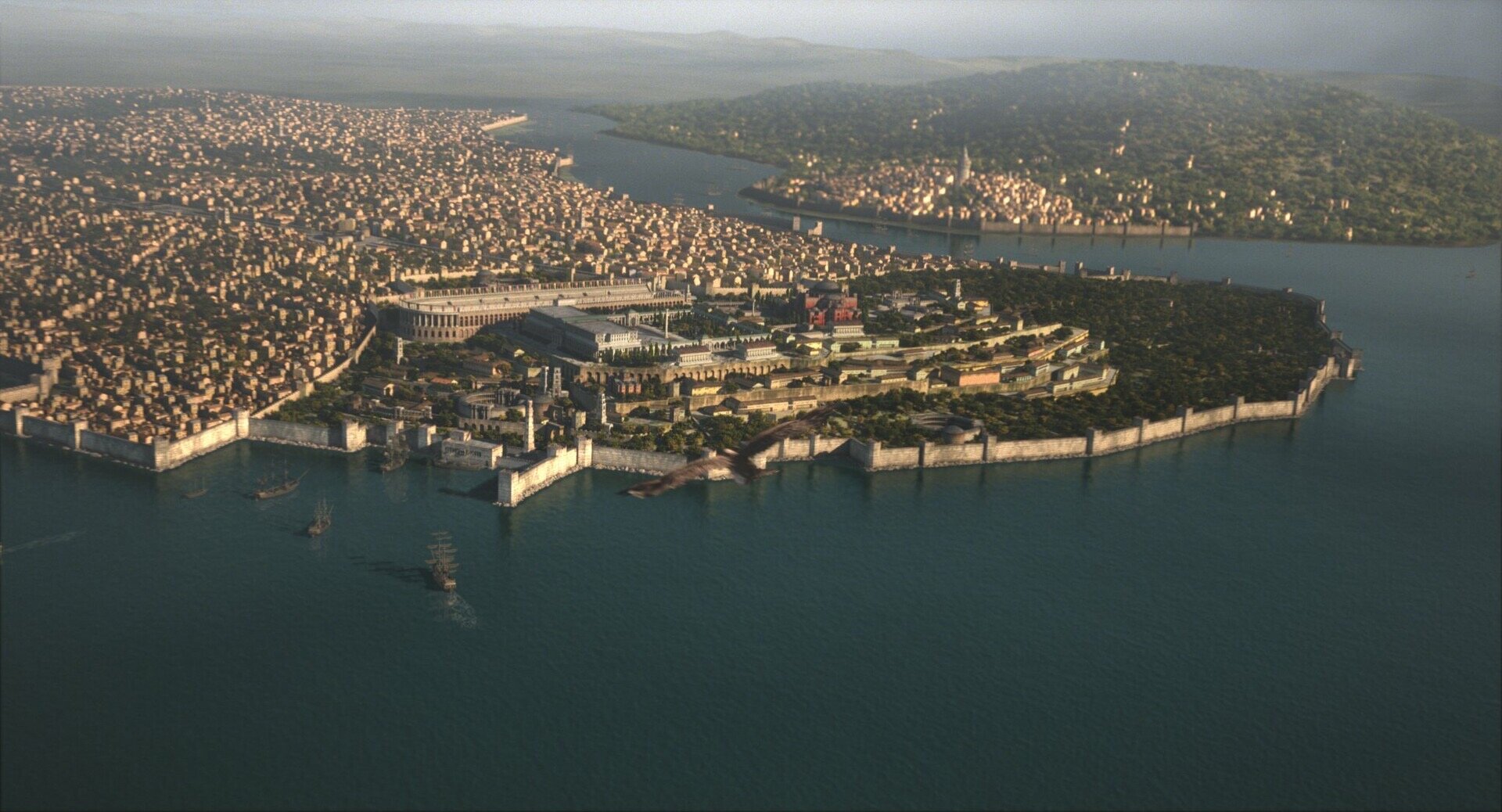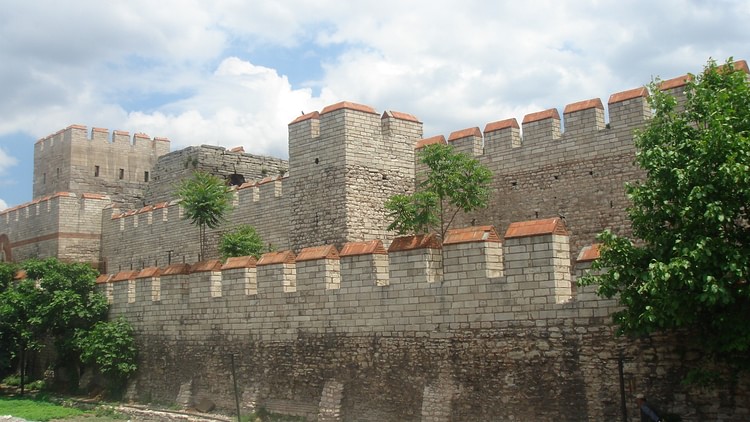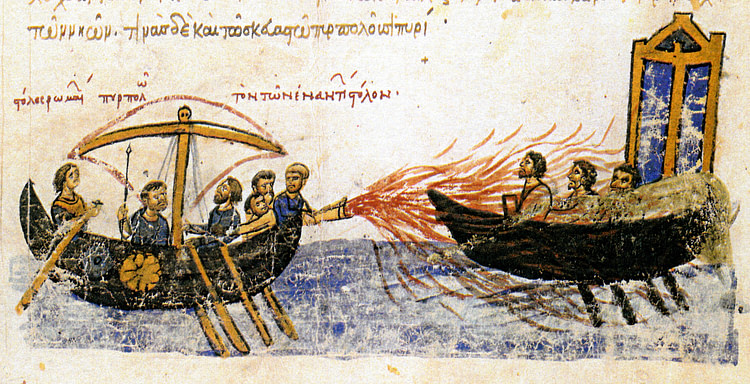
Constantinople, modern-day Istanbul, was renowned for being one of the most difficult cities to conquer in history. This was due to its unique geographical location, formidable fortifications, well-organized defense plans, and the resilience of its inhabitants. Here's an exploration of why Constantinople remained unconquered for so long.
Geographical Advantage

Constantinople, strategically located on a horn-shaped peninsula where Europe meets Asia, dominated the Bosphorus Strait, the natural waterway that links the Black Sea to the Mediterranean. This unique position provided both natural protection and significant control over maritime routes[3][5]. The city’s position allowed for swift reinforcement and supplies by sea, making it difficult for besiegers to cut off all lines of support[5].
The Theodosian Walls

The most significant factor in the defense of Constantinople was the Theodosian Walls. Constructed in the early 5th century under Emperor Theodosius II, these walls were a marvel of engineering and provided unprecedented protection for the city[8]. The walls included a triple-layered defense system:
Outer Wall and Moat: The attackers first faced a wide moat. Just behind the moat was the outer wall, equipped with patrol tracks[6].
Middle Wall: Behind the outer wall was a second wall with regular towers and a terrace for firing down on attackers[6].
Inner Wall: This was the greatest defense, an inner wall almost 5 meters thick and 12 meters high with 96 projecting towers[6]. Each tower could hold multiple artillery machines, making the wall almost impregnable.
These defensive mechanisms ensured the city could resist even the most formidable of medieval siege engines and tactics[6][8].
Military Organization and Strategy
Constantinople's defenders were well-organized, highly disciplined soldiers who fought with determination. Historical accounts, such as the defense against the Avars and the Persian Sassanid Empire in 626 AD, highlight the disciplined resilience of Byzantine soldiers[2]. During sieges, the defenders exhibited exceptional coordination, such as launching a counter-attack from the navy while the Persians attempted a crossing, showing their adeptness in handling multi-front assaults[2].
Furthermore, the leadership of notable Byzantine commanders played a crucial role. Figures like Constantine XI and Giovanni Giustiniani Longo were instrumental in ensuring the morale and effective defense of the city during sieges[1][6].
Naval Defenses

Constantinople’s ability to defend itself from naval attacks was another critical factor. The Byzantines fortified the Golden Horn—a natural harbor—with a great chain that could be raised to prevent enemy ships from entering[1][5]. This chain, combined with a fleet of warships, ensured that the sea walls remained primarily safe from amphibious assaults. This tactic successfully repelled several naval attacks during sieges[1][5].
Advanced Engineering and Innovations
The defensive prowess of Constantinople was also due to continuous improvements and innovations in their fortifications. The moat itself could be flooded with water to hinder enemy movement and make direct assaults more difficult[6]. The city’s defenses were further enhanced with reinforced gates like the Golden Gate, which was both a symbol of imperial authority and a strategic stronghold[8].
The ability of the Byzantines to effectively utilize fire-based defenses such as Greek Fire, a highly flammable liquid used to repel enemy ships and troops, gave them an edge in many encounters, notably in the sieges by the Arabs[6].
Resilience and Resource Management
Beyond physical defenses, Constantinople’s defenders were adept at resource management and maintaining morale. During sieges, the Byzantines demonstrated their ability to quickly repair breaches in the walls and adapt to evolving battle conditions. The usage of rubble and barrels to fill in gaps created by cannon shots during the siege of 1453 is a testament to their resilience and ingenuity[6].
The Decline and Final Siege
Despite these formidable defenses, Constantinople eventually fell to the Ottomans in 1453, primarily due to the advancements in siege technology. Sultan Mehmed II’s use of massive cannons, a technology that had eluded previous attackers, marked a turning point[1][6]. These cannons were capable of creating breaches that even the most disciplined defenders could not repair quickly enough[1][6].
Additionally, Mehmed II's strategic planning and innovations, such as bypassing the chain protecting the Golden Horn by transporting ships overland, showcased the evolving nature of military strategy that eventually overcame the city's defenses[1][4]. The overwhelming number of Ottoman troops, coupled with the advanced artillery, sealed the fate of the once impregnable city[1][6].
Conclusion
Constantinople’s reputation as an unconquerable city was well-earned through its strategic geographical location, its elaborate fortifications such as the Theodosian Walls, its robust military defenses, and the sheer will of its defenders. These elements combined to make it one of the most formidable cities in medieval history, withstanding numerous sieges across centuries until the advent of gunpowder artillery changed the landscape of warfare forever. Thus, even the mighty Constantinople's defenses could not hold indefinitely against the relentless tide of technological advancement and strategic brilliance demonstrated by the Ottomans in 1453.
Get more accurate answers with Super Search, upload files, personalized discovery feed, save searches and contribute to the PandiPedia.
Let's look at alternatives:
- Modify the query.
- Start a new thread.
- Remove sources (if manually added).
- Request a manual search from our human research team.